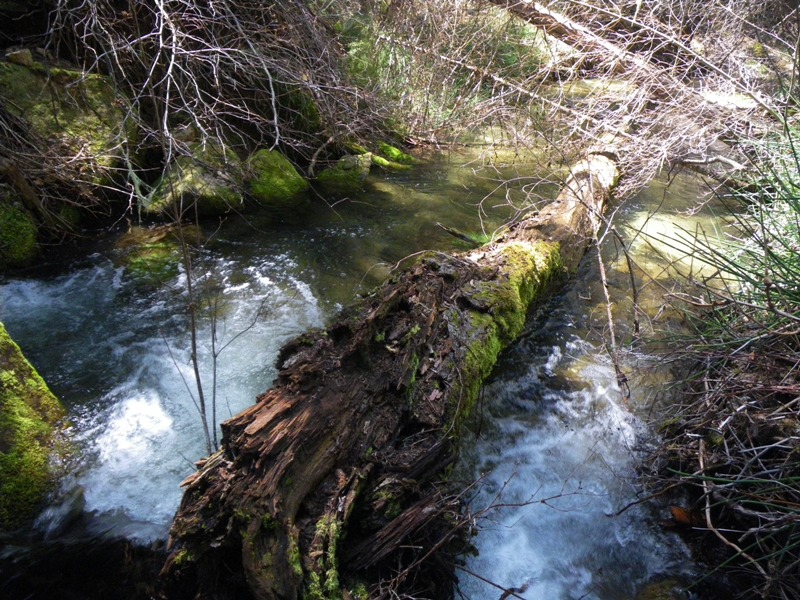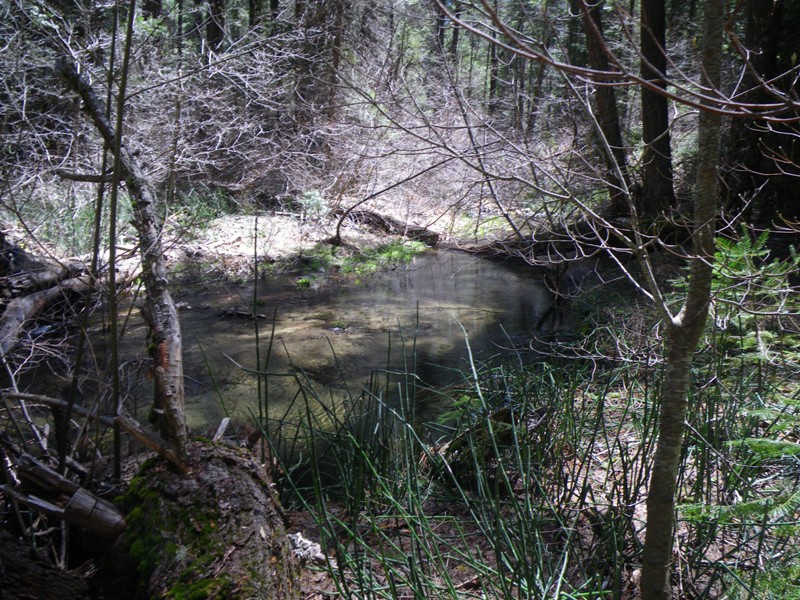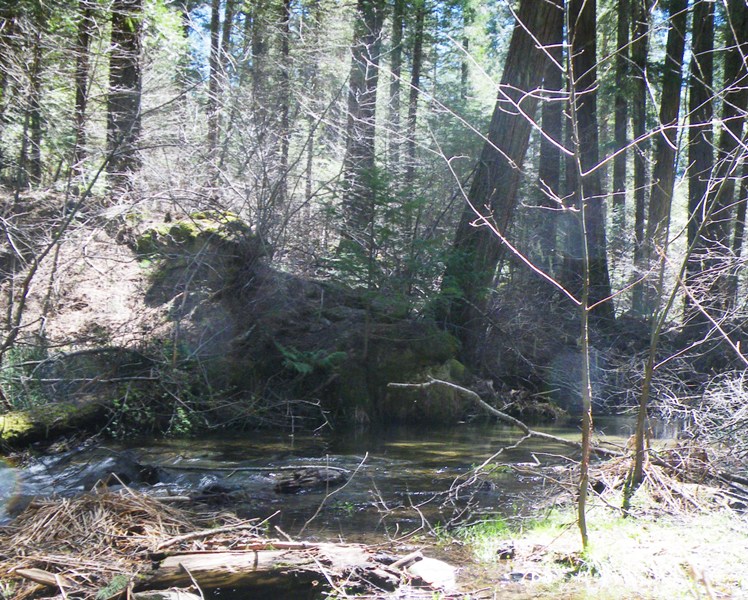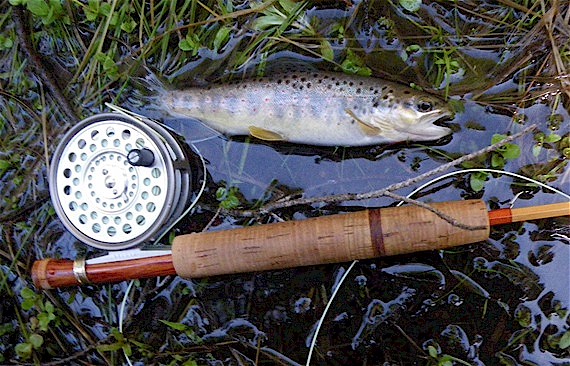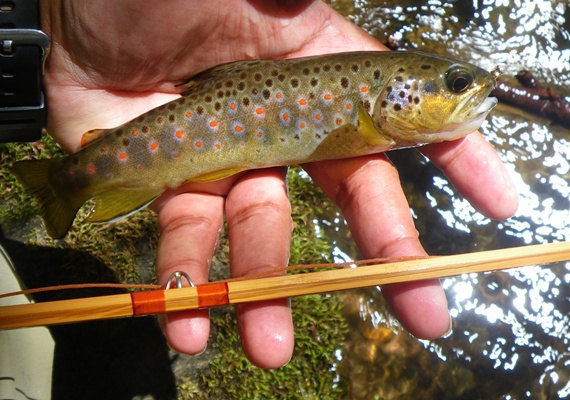|
|
|
|
|
May 2nd 2010- North Green Creek, Yosemite National Park Time:
Noon to 4:00pm Narrative:
The drought hath ended! Itís been 6 months since Iíve felt the tug of a Salmonid at the end of my line, in this case Salmo Trutta, and it was long over due. Yesterday was a good warm up for next weekís strip to Butterball Creek. Slightly larger than Butterball Creek, North Green Creek (not its real name) is just as brushy with LOTS of fallen timber and spooky trout. Itís an exercise in bow and arrow casting, line control and climbing over and under broken and sometimes punky tree trunks. One tree actually gave out from underneath me. It held my weight for about a minute and then sent me plunging into the stream. Itís a stream that is well suited to dapping and downstream fishing if thatís your thing. Many of the best holding areas are a jumble of tree limbs and even bow and arrow casting is a real change. One might be able to cast to a fish but try to mend line or cast into slower current and the hang ups come thick and fast. I had to throw a lot of curved, bow and arrow casts by casting side arm. I attacked the stream using my 7ft 3wt rod which Iíve decided to christen as the ďStairway CreekĒ or SWC taper. Iíve named it mainly because folks keep asking me about it and I canít keep calling it ďmy SLT 3wt.Ē Most of my rod designs at present are Straight Line Taper rods, so SLT is rather vague and ubiquitous. I also fished a silk line which I found at an antique store last fall. While itís fine to cast with and probably good for tight line nymphing on a stream like Hot Creek (where its narrow diameter wonít catch the wind); itís not well suited to brushy steams, bow and arrow casts and roll casts. To be fair, itís a level line and probably should not be used on a stream where a short casting stroke, with very little line loading the rod, is needed. Getting to the stream can be a bit of a chore, the hike isnít terribly difficult but old, fallen Lodgepole pine are everywhere- on the trail as well as off. I bushwhacked downstream in order to fish my way back up and when I picked a fallen tree as an obvious spot to cross the stream, I found a fresh footprint exactly where I planned to place mine. I wouldnít be the first to fish this stream this year. I worked my way upstream, casting from the left bank whenever possible. Iím right handed and itís often easier for me to fish brushy streams with my casting hand over the water. I waded as well. I think extremely brushy streams like this have to be waded if youíre planning to fish with an upstream presentation. Admittedly, many parts of the stream were more suited to a downstream presentation.
I missed the big fish of the day almost immediately. It was hunkered down under a log in the pool above the fallen tree I used to cross. I hadnít planed to start fishing at that spot, so I walked across the log as easy as you please and probably pushed the fish under cover. Once across the stream I looked downstream and then looked up. It would be tough going either way and since this was my first visit, I figured Iíd simply start working my way upstream. Enter the perfect big fish lie, right at my feet. Earlier, as I crossed a smaller creek, I tied on a bead head hareís ear and landed my first fish of the year. I dropped that same fly along the edge of the submerged log and out shot a 10 or 12 inch Brown Trout. It looked to me as if heíd rejected the fly, so I did not strike. I let the fly drift to the back of the run and dropped it in again. Again the brown trout shot out from underneath the log, only to turn around in half the distance. A third drop of the fly was met with a slight peaking of its head from the shadow of the log and additional casts were ignored. Not to be outdone, I switched to a black version of the same fly. This time the trout attacked the fly more aggressively but turned around as the fly apparently drifted out of the fishís feeding zone. On the next cast the fish intercepted the fly early and when it was just about to grab the fly, our eyes met. It was like catching the glance of someone from across a crowded room. There was a sense of recognition and then the thought of ďuh-ohĒ. Iíd been seen and recognized for what I was, a predator. The fish took no further interest in anything I had to offer so I moved on. I switched to a dry fly and then trudged my way upstream through the fallen timber and brush. Much of the day is a blur. I destroyed the very first opportunity I had to hook a fish on a dry fly. I had the scenario all worked out in my head as I approached a smooth run with no overhanging brush. I could see two fish working at the head and a couple smaller fish on station at the tail.
The fish at the tail were effectively small sentinel fish that would announce my arrival if I wasnít careful. I pulled the silk line off my reel. The reel was also new, a limited edition Hardy Tealweight II given to me by my friend Erik. I prepared to make the perfect bow and arrow roll cast to an 8 or so inch fish in the center of the run. Immediately, the supple line caught the current at my feet and tangled with every rock, stick or log in the immediate area. I gathered up the line and held it in loops in my hand. I was going to make the perfect cast. I pulled back on line and releasedÖ.the line crumpled in a pile below my rod tip. I hadnít spooked the sentinel fish so I gathered up my line for a second cast. The line landed mid run but some was caught by the stronger current at the tail and pulled downstream immediately. I needed a right reach. The sentinel fish were gone but hadnít spooked my two target fish. I made another cast with a reach to right. Too short! I tried to roll cast the line back upstream only to have it catch on a twig. I pulled even more line off the shiny green reel and made another cast and the line again crumpled, not turning over the leader and spooking the fish. So many times Iíve been in this scenario and so many times Iíve pulled it off on the first, second or third cast. On the first cast I maybe get the distance wrong. On the second I might need to make an adjustment for drag but with the third cast itís usually fish on or fishing running for cover. I fished the silk for an additional hour but when I flubbed the cast to a big fish in a similar scenario, I hopped on the bank and switched lines. Iíd anticipated that I might not like the silk line and brought with me a second new line, a Sage Quiet Taper DT3, also on a new reel- a Hardy Featherweight*. The Sage fly line gave me the performance that I wanted but the fish still werenít coming. My luck finally changed when I moved up to a run split by a large fallen pine. On the right was a deep fast pocket, on the left a calmer shallow pool and at the tail a prime lie of roots and overhanging branches. Before I approached I could see some fish working in the tail of the run, just ahead of the shelter the entangled timber would provide. Unfortunately, my approach made it impossible for me to fish to those fish. Unless I tackled the run from behind an upstream tree, Iíd have to be content with fish to the edge of the submerged tree. I approached it just as one should. I carefully placed cast after cast in all the likely places switching from caddis dry, to nymph, to para adams and finally to a new black ant pattern I picked up at the fly fishing show. All imitated the insects that Iíd seen on the stream and not one worked. I finally decided to use the ant pattern that works well for me at Butterball Creek. I struggled with this. Iíd thought about using the pattern earlier but instead put on ďbetterĒ flies. The creeks are very much alike, both have wild brown trout, both are in Yosemite, both are brushy and most important of all, both have large black ants. The pattern isnít anything special. A simple strip of foam with legs made of a shinny, stringy, rubber material. It lands with a plop and floats deep in or underneath the surface film, perhaps like a real ant. Whatever the case, a fish grabbed it on the first cast and another fish grabbed it on the third cast to an area Iíd thoroughly covered previously. New fly in hand I continued my journey up the creek. In retrospect, I fished a very little stream. The constant crawling under and around timber, climbing out of the stream and over trees kept me from progressing very quickly. It was late afternoon when I finally arrived at the trail. A pool formed below a small stone bridge and the last fish of the day was landed here. On the way back to the car, I hooked into another Brown and several Brook Trout on a smaller trib. Next weekend I plan to tackle Butterball Creek, land of sticks and big trout. This trip should have gotten the rust out. We'll see how it goes....
Previous Yosemite / Ansel Adams Wilderness Chronicle Next Yosemite / Ansel Adams Wilderness Chronicle
|

